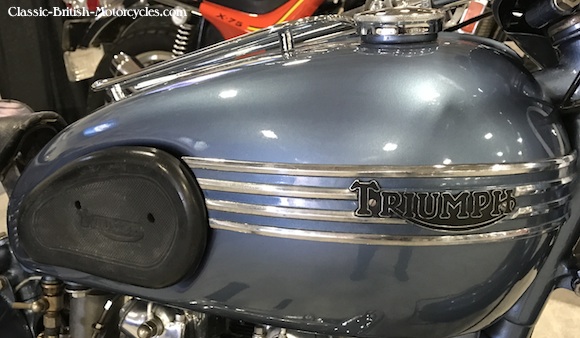1954 Triumph Thunderbird
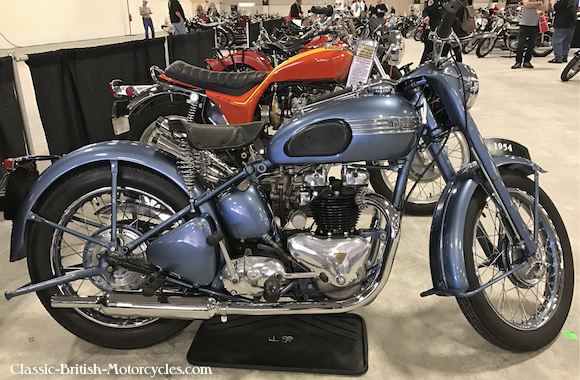
ABOVE: An early-1954 Triumph Thunderbird with rigid frame.
BELOW: Partway through the 1954 model-year Triumph converted over to a swing-arm rear suspension setup, as seen on this ’54 T-Bird.
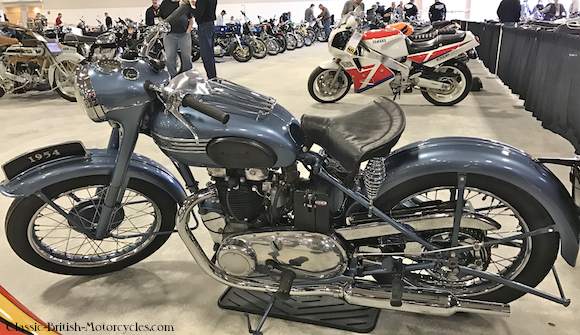
1954 TRIUMPH THUNDERBIRD’S ‘SISTER-BIKE’
The 1954 Triumph Tiger were “sister-bikes”, in that they were very similar in appearance. In this era of Triumph Motorcycle history, the Tiger was always the “hot rod”-version, with higher compression, wilder cams and bigger carbs, be it in 500cc form as the T100, or 650cc form as the T110. The 6T Thunderbird line then, was given milder tuning and was relegated to touring and commuter duty.
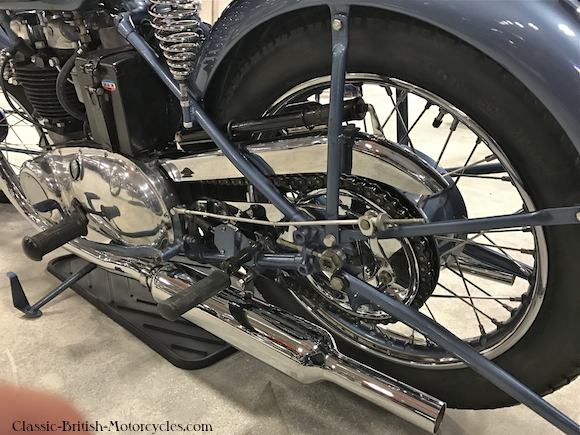
ABOVE: The simple construction of the sturdy rigid frame.
1954 TRIUMPH THUNDERBIRD – A BIG YEAR
1954 was a big year at Triumph Motorcycles, in general. Finally the archaic rigid frame and troublesome sprung rear hub were ditched for a proper swing arm frame. Not a moment too soon, either. AMC, Royal Enfield & the BSA Gold Star were already running swing arms and Norton was about to introduce the swingarm-equipped Norton Dominator with the legendary Featherbed Frame. Triumph had some catching up to do. This would prove to be a year of change for the Triumph motorcycle line.
1954 TRIUMPH THUNDERBIRD & THE NEW TIGER T110
1954 was also the year Triumph introduced the hot new Triumph Tiger T110. The new top 650 model was the high-performance variant and it’s development trickled down to the other models. The Tiger T110 featured higher compression, wilder cams and a bigger carb, and still ran a magneto, offering much more performance. The 1954 Triumph Thunderbird, once the flagship of the Triumph Motorcycle line & the fastest bike they produced, was now marketed as the detuned, commuter (or ‘plodder’) version, although the two bikes continued to be styled almost identically.
1954 TRIUMPH THUNDERBIRD – RESTYLED
The 1954 Triumph Thunderbird was extensively restyled, as were all Triumphs, with a new look that somehow retained its historical relevance with Triumphs past. They looked great! A new color, Shell Blue Sheen (pictured here on the 1954 Tiger T110) was striking on the new bikes.
BELOW: Prior to the adoption of a swing-arm setup, Triumph used their infamous “Sprung Hub” to provide some rear suspension movement. A poor compromise, at best.
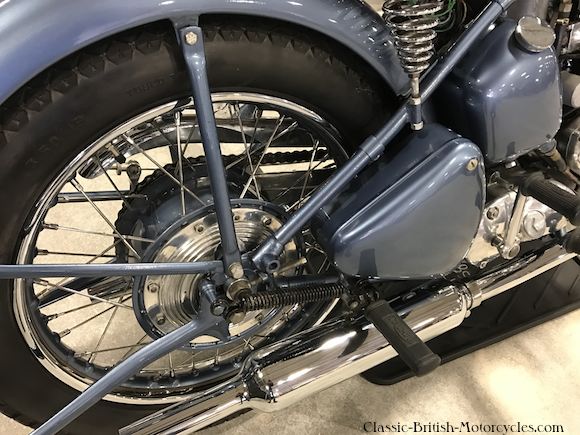
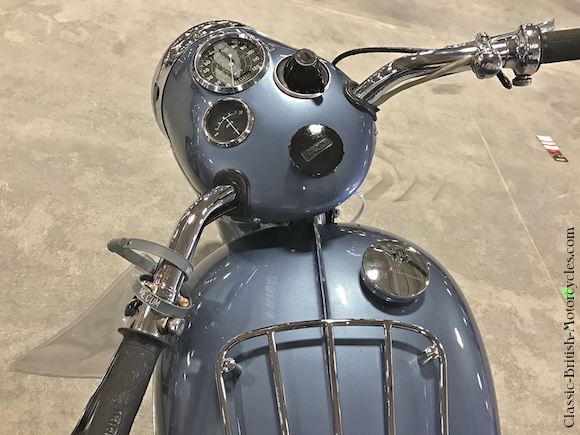
1954 TRIUMPH THUNDERBIRD DETAILS
This 1954 Triumph Tiger T110 shows the new Shell Blue Sheen paint color. The ’54 T110 differed from the 1954 Triumph Thunderbird in that that Tiger had a hotter engine and it retained the magneto & dynamo, whereas the T-Bird had the new-fangled alternator & coils.
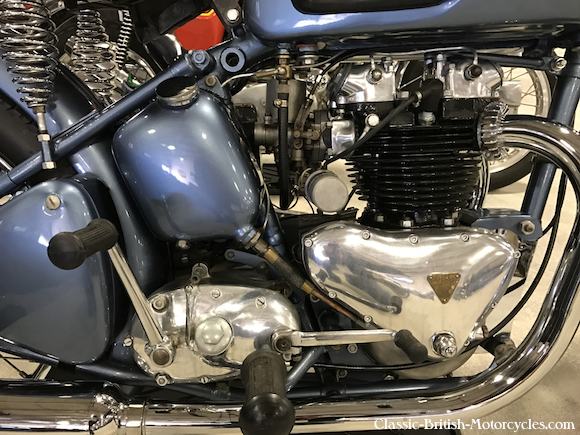
1954 TRIUMPH THUNDERBIRD – SOUPED-UP 650
Performance also got a big shot in the arm for the 1954 Triumph Thunderbird. The entire Triumph 650 line got a stiffened crankshaft with increased shaft diameters, larger conrods and a new crankcase with larger 1-1/8″ MS11 ball race on the timing side. Revisions to the primary cases were made to accommodate the new Lucas RM14 3-lead alternator.
1954 TRIUMPH THUNDERBIRD – NEW SWINGARM FRAME
The new swingarm frame shortened the wheelbase by 1-inch, to 55-3/4″. It was a single front downtube with the swing arm pivot mounted to the saddle tube and nothing else. The vertical saddle tube flexed like a torsion bar, allowing the swing arm to move sideways. This would end up being a real problem on the higher performance Triumph Tiger T110 & much later on the first year 1959 Triumph Bonneville. Because of this tendency to weave, the frame gained the nickname “Whip Iron”.
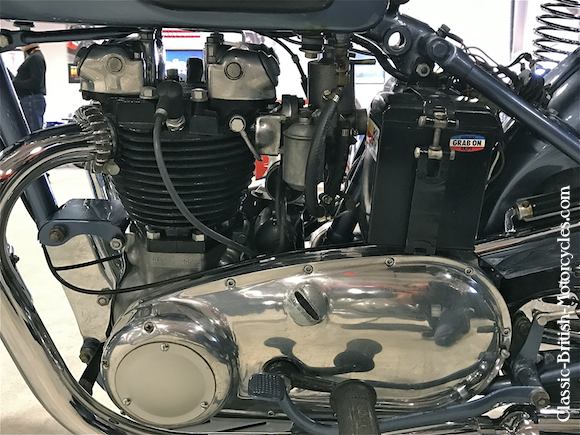
GEARING
The engine package was also made more compact by pushing the gearbox closer to the crankcase and shortening the primary cases. The primary chain was down to 70 links. Out back, the lower half of the chain guard was deleted. The gearbox cases were modified along with a new adjusting (rotating the gearbox in its mounts as the only means of adjusting the primary chain tension) and clamping system. The gear indicator pointer was also dropped.
RUNNING GEAR
Front fork springs were lengthened to 20 inches and rear shocks were 3-position slim-bodied Girlings with 110lb springs early in the year, with 125lb springs mid-year on. A centerstand appeared for the first time ever on a Triumph motorcycle.
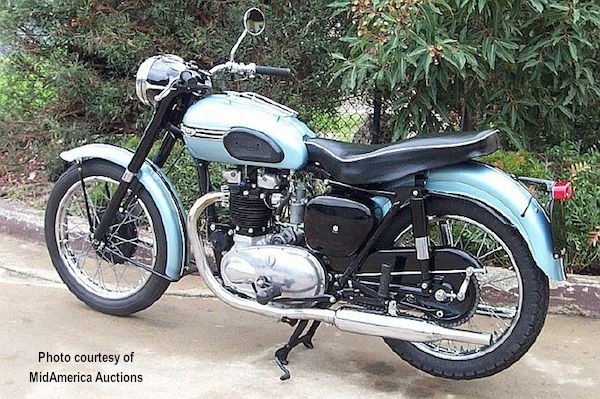
ABOVE: This is a 1954 Tiger T110. The new swingarm rear suspension and Girling shocks are visible here. One key difference in appearance between the Tiger and the T-Bird is the primary covers. The ’54 T-Bird had an alternator which required a larger bulge in front than this.
NEW BODYWORK
The new frame called for many new parts, including a new oil tank (claimed to be 6 pt, but was actually only 5) which also housed the battery tray, air cleaner & tool box. As always, the 6T Thunderbird came with well-valanced fenders, a new stepped two-place seat & headlight nacelle.
T-BIRD BECOMES THE COOKING MODEL
With the introduction of the red-hot T110, the 6T T-Bird was no longer the top model. Starting with in 1954, it became relegated to what the Brit’s call a “cooking model”, or basic commuter, and sidecar duty, pretty much from then on for the rest of its career. Until the arrival of the Triumph TR6 in 1956, then the Triumph Bonneville in 1959, the Tiger T110 was the ‘hot rod’ model, chruning out 42hp and easily breaking “the ton” (100mph). This all lead to overheating problems in the T110 that didn’t affect the 6T as much, because of its lower performance. The changes that were made to the T110 to solve its problems trickled down to the rest of the line, including the 6T Thunderbird.
1954 Triumph Thunderbird SPECIFICATIONS
|
Engine type Displacement Bore & Stroke Compression Carburetor Ignition Engine output Primary drive Primary sprockets Clutch Gearbox Ratios, overall: 1st, bottom 2nd 3rd 4th, top Final drive Final drive sprockets Frame Type Suspension, front Suspension, rear Brake, front Brake, rear Tire, front Tire, rear Wheelbase Seat Height Ground Clearance Fuel capacity Dry weight |
Air-cooled OHV vertical twin, non-unit 649cc / 40.0 ci 71mm X 82mm / 2.79″ X 3.23″ 8.5:1 (US & export); 7.0:1 (UK) 1-SU Type MC2 Lucas magneto 34 bhp @ 6500 rpm 1/2″ X .335″ X 5/16″ chain, 70 links 24T X 43T Multi-plate, wet 4-speed constant mesh, right foot shift — 11.9:1 8.25:1 5.81:1 4.88 5/8″ X .400″ X 3/8″ chain, 101 links 18T X 46T Brazed lug, rigid Telescopic fork, hydraulic damping Swing arm, 2 Girling dampers 8″ SLS drum 7″ SLS drum 3.25″ X 19″ 3.50″ X 19″ 55.75″ / 141 cm 31″ / 77.5 cm 5″ / 12.7 cm 3 Imp gal (US); 4 Imp gal (UK & export) 395 lbs / 179 kg |


